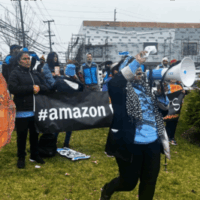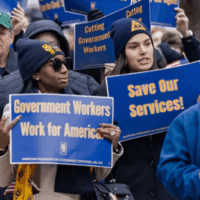Across the country, workers are demanding billion-dollar companies like McDonald’s and Walmart pay a $15 hourly minimum wage. And they are winning. In the nearly four years since the Fight for $15 began, more than 17 million workers have won big raises as a direct result of the movement. Democrats added the once pie-in-the-sky $15 wage to their convention platform and cities and states across the country are racing to raise pay.
At the same time cooks and cashiers are winning huge wage increases from coast to coast, regulators and policymakers have seemed willing to let behemoths like Uber off the hook, resulting in paltry pay for the folks who are literally driving the “new economy.”
Recently, Buzzfeed broke the news that Uber drivers in Detroit bring home poverty-level wages of $8.77 per hour. The Buzzfeed analysis of leaked Uber documents also showed that drivers in the Houston area earn$10.75 per hour, while those in the Denver market earn $13.17 per hour. These figures take into consideration the extensive car-related expenses that drivers shoulder for the privilege of driving for Uber, but still undercount expenses. They leave out expenses like the 15.3% these workers pay in self-employment taxes, use a reimbursement rate lower than that used by the IRS, and seem to count only the time drivers actually have a fare in the car, not the time spent on-duty cruising for fares.
Given Uber’s constant price-dropping in its no-holds-barred bid to corner the market, even drivers who had no waiting time at all would find it mathematically impossible in some cities to earn at minimum wage. This is hardly the $90,000 average annual gross pay that Uber reportedly posted on its blog as the median for its New York City drivers. And the culture of low fares and no tips is trickling down into the regulated taxi industry, setting off a workforce-wide race to the bottom where sub-minimum, part-time only gig work awaits.
Meanwhile, the fight for a $15 minimum wage has swept the nation. Beginning with a few brave fast-food workers in New York City who went on strike for $15 and union rights, the movement has spread to 300 cities on six continents. It now includes home care workers, airport workers, child care teachers, adjunct professors and retail employees. Cities have taken up the call, with Seattle, Los Angeles, New York City, the District of Columbia, and others passing $15 per hour minimum wages. States like California, New York and New Jersey have taken up the fight as well, and campaigns are active in states and cities around the country.. The fight for a $15 hourly minimum wage has become central to reversing the yawning gap in our country between its wealthiest citizens and the rest of us.
Like the profitable corporations that call the shots for fast-food workers and the home care industry, Uber is sitting on a valuation of $66 billion. And Uber drivers’ wages are comparable to those of fast-food and home care workers, who earn a median wage of $9.09, and $10.54, respectively. Like these fast-food and homecare agencies, transportation network companies hide behind sham work structures – franchises in the case of fast food, so-called “independent contractor” schemes in home care and transportation – to disclaim responsibility for the workers who make their hefty profits possible.
And what about the “union” part of the demand for $15 and a union? Transportation network drivers, who have staged strikes in cities from New York to San Francisco, Austin to Dallas clearly want to negotiate the terms of their jobs with the company. Like fast-food workers, they face enormous obstacles to organizing, not the least of which is that Uber claims its drivers are not employees entitled to the protection of the National Labor Relations Act. And like fast-food workers, they have found and are continuing to find ways to come together – In New York, the New York Taxi Workers Alliance represents 5,000 Uber drivers among its 19,000 members. The Taxi Workers Alliance recently filed litigation on behalf of its Uber members, challenging their misclassification of drivers as independent contractors and the sub-prime loans that Uber uses to lock them into continuing to work for subminimum wages.
We can make sure that this new sector of low-wage workers benefit from the momentum of the Fight for $15. Taxi and for-hire-vehicle drivers need to be included in state minimum wage increases and city regulators, like those from New York and Seattle, can add weight to the state’s enforcement. And when Uber and taxi drivers next take to the streets – as we know they will – the demand for a $15 minimum wage should be front and center.
Read the original op-ed at The Huffington Post.
Related to
The Latest News
All newsMayor Bowser & D.C. Council Must Respect the Will of D.C. Voters by Rejecting Repeal of Initiative 82

Blog
New Brief Sheds Light on the Amazon’s Dangerous ‘Flex’ Labor Model

News Release
NELP Denounces Supreme Court Ruling Permitting Immediate Layoffs of Hundreds of Thousands of Federal Workers

News Release

